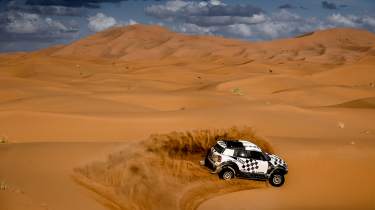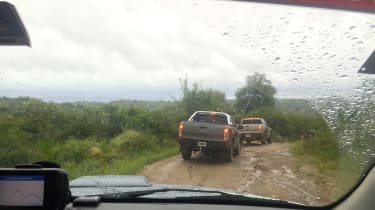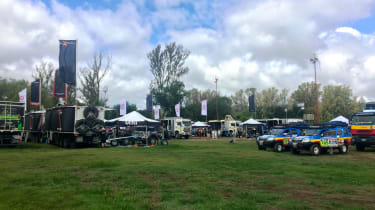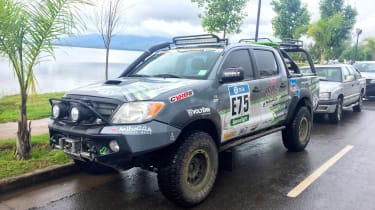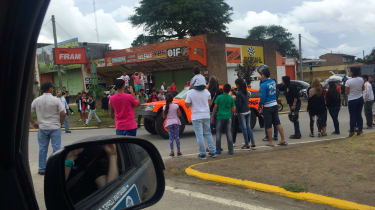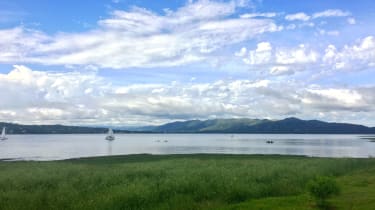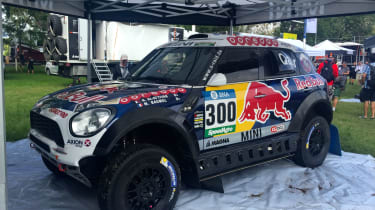Dakar Rally 2016 blog - part 4 - Dakar 2016 - day 2
Daily updates from the incredible 9596km race
Sunday, 3rd Jan 2016 - special stage
We were up before the bin men this morning to get to the first full-length special stage of the event in time to watch the 112-strong field of cars pass through. After two hours our convoy of 20 or so off-road vehicles turned off the metalled highway and onto a gravel track.
Wide and smooth at first, the track gradually tightened around us until it was single-width. The surface got rougher and more rutted, too, until we were crawling along in low-range. The weather was foul; clouds low and heavy, rain falling persistently. It rained throughout the previous night, in fact, and the lightening show from my eighth storey hotel room was the most spectacular I’ve ever seen.
The track got thicker with mud as we pressed on. It felt quite intrepid, actually, tackling that punishing path with our winches, snorkels and chunky off-road tyres. Then a completely standard Peugeot 206 passed us in the opposite direction without any fuss and we were made to look very stupid. Like a bunch delusional walkers wearing brightly-coloured mountaineering gear to traverse the perilous north face of Hyde Park.
After an hour we reached our vantage point on the first stage. The surroundings were hilly, rather than mountainous, and verdantly green. Apparently heavy rainfall is not at all unusual around here during the summer months. This section of special stage was much more like a typical sprint rally stage than I had expected. The never-ending dunes, barren deserts and featureless salt flats will come later in the event.
Frustratingly, the rain meant the stage was cancelled before it had even begun. It’s easy to be a bit sniffy about the world’s toughest motorsport event being brought to a halt by some rain, but the real reason for cancelling the stage was that the medical helicopters just couldn’t fly in those conditions. The accident on the previous day’s prologue stage – in which a number of spectators were hit by one of the cars with four being seriously hurt – is a reminder that those helicopters must be on hand at all times.
After a soggy bite to eat we cut our losses and drove another two hours to the bivouac. Don’t worry, I hadn’t either. A bivouac is a sort of traditional shelter, but in this context it refers to the traveling service park. The weather cleared in the afternoon, which persuaded crowds of locals to line the streets in the towns along the route of the rally. They waved and cheered and I could see their faces light up when they clocked our Hilux.
It has a couple of spot lamps on the front and lots of garish stickers (which is exactly why I was drawn to it in the first place), so I reckon some of the locals mistook us for one of the rally cars. I waved back, disingenuously. I may not have seen any cars out on the stage, but I did catch a glimpse of the bright orange #312 machine on a road section, driven by the ‘bad boy of the Dakar’, Gordon Robby. He sounds like a Will Ferrell character. Irritatingly, some children ruined my photograph.
We got to the bivouac at 3pm. On this day it was based in a very picturesque lakeside setting in Carlos Paz, an hour or so north-west of Cordoba, but it follows the rally and serves as the base throughout the fortnight. The term bivouac is a throwback to the days when the Dakar Rally was held in Africa and the drivers and team members would eat and sleep in a temporary shelter. It was the very heart of the event. These days the big teams take care of their own catering and put their drivers up in hotels wherever possible, but the term has stuck and the Dakar community still refers to a bivouac rather than a service park.
It wasn’t the hive of frantic activity it would normally have been because the day’s competitive action had been cancelled. We’re still waiting for the rally to really get underway. I did catch up with lead British entrant Harry Hunt, though. I’ll share what he had to say in the next instalment.
I’ve included a few of my own photos from the bivouac. You’ll notice they’re terrible. There are two reasons for this: one, my camera is also a telephone and two, my incompetence.
There’s talk of the heavy rain returning in the morning. If tomorrow’s stage is cancelled as well I’m claiming a rally spectating world record for the highest number of miles travelled versus the fewest minutes of action witnessed. Fingers crossed for sunshine.
